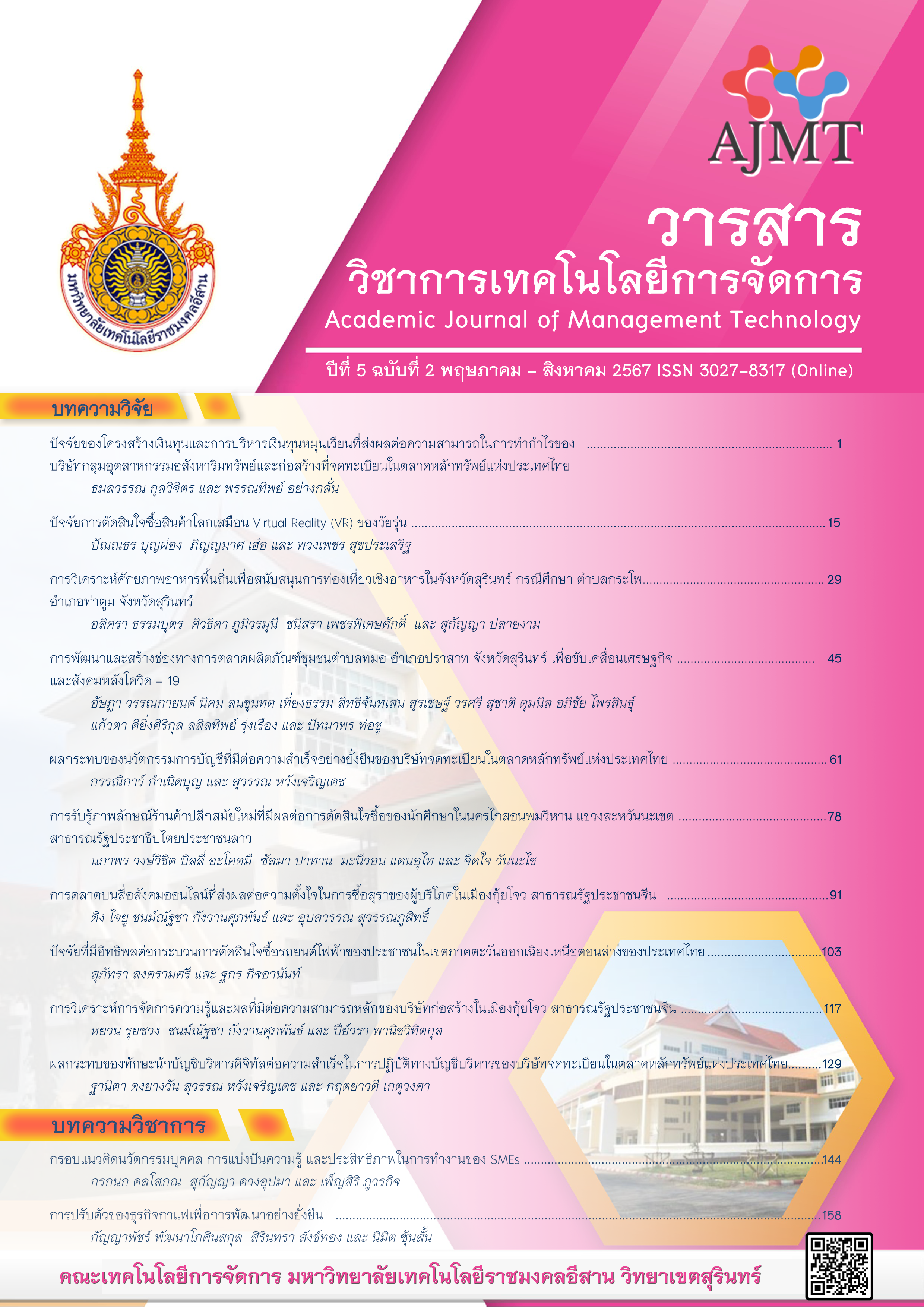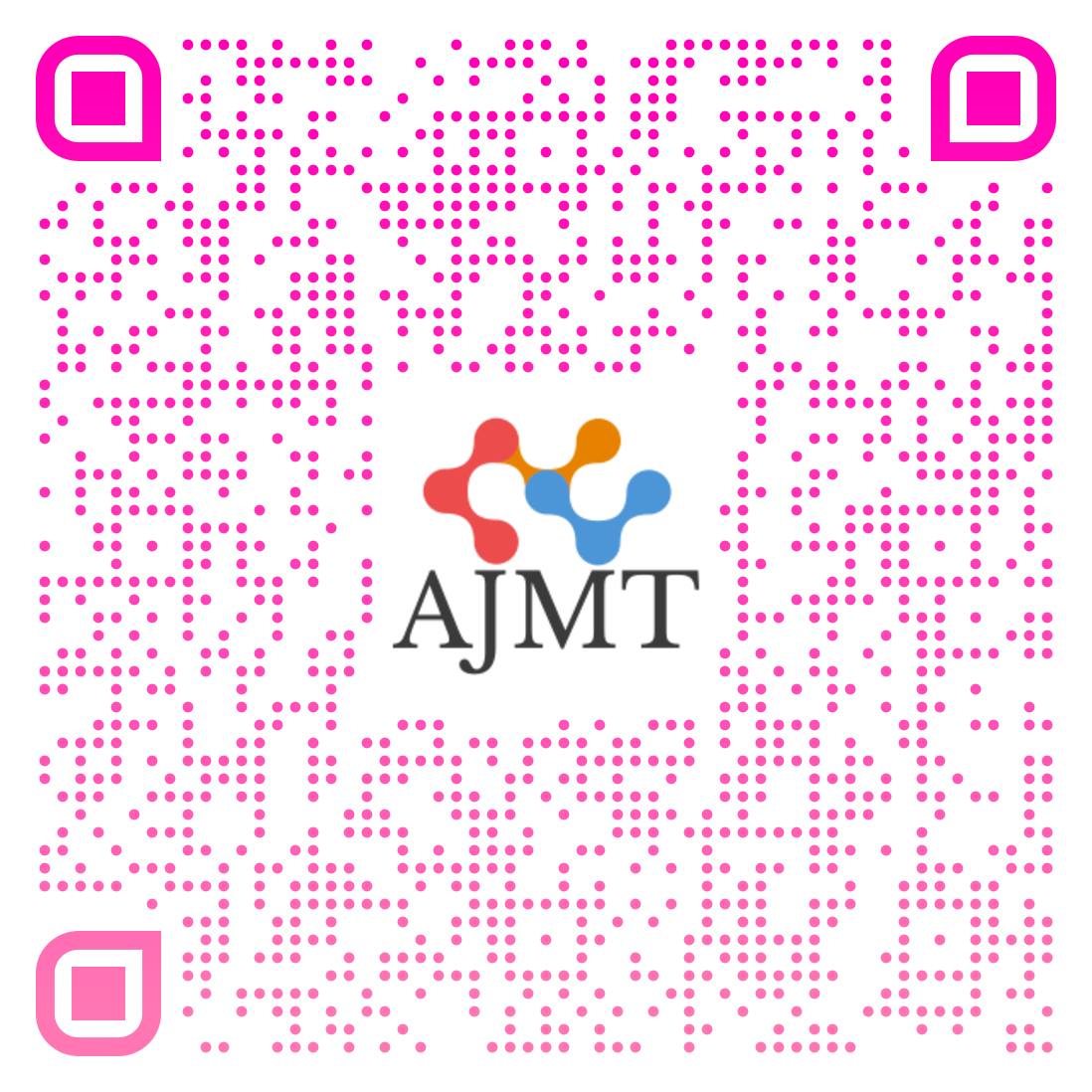การตลาดบนสื่อสังคมออนไลน์ที่ส่งผลต่อความตั้งใจในการซื้อสุราของผู้บริโภคในเมืองกุ้ยโจว สาธารณรัฐประชาชนจีน
DOI:
https://doi.org/10.14456/ajmt.2024.16คำสำคัญ:
การตลาดสื่อสังคม, ความตั้งใจซื้อ, สุราบทคัดย่อ
การวิจัยนี้มีวัตถุประสงค์เพื่อ 1) ศึกษาระดับการตลาดบนสื่อสังคมออนไลน์ และความตั้งใจในการซื้อสุราของผู้บริโภค ในเมืองกุ้ยโจว สาธารณรัฐประชาชนจีน และ 2) เพื่อศึกษาผลกระทบของการตลาดบนสื่อสังคมออนไลน์ต่อความตั้งใจในการซื้อสุราของผู้บริโภค ในเมืองกุ้ยโจว สาธารณรัฐประชาชนจีน การศึกษานี้ใช้วิธีการเชิงปริมาณ โดยมุ่งเน้นไปที่ผู้บริโภคที่ซื้อสุราในเมืองกุ้ยโจว สาธารณรัฐประชาชนจีน กลุ่มตัวอย่างประกอบด้วยผู้บริโภค 387 ราย และเก็บรวบรวมข้อมูลโดยการสำรวจผ่านแบบสอบถามออนไลน์ ใช้โปรแกรมสำเร็จรูปทางสถิติเพื่อวิเคราะห์ข้อมูลเทคนิคการวิเคราะห์ ได้แก่ ความถี่ เปอร์เซ็นต์ ค่าเฉลี่ย ส่วนเบี่ยงเบ มาตรฐาน และการวิเคราะห์การถดถอยพหุคูณ ผลการวิจัย พบว่า การตลาดบนสื่อสังคมออนไลน์โดยรวมอยู่ในระดับสูง องค์ประกอบทุกด้านของการตลาดผ่านสื่อสังคม ได้แก่ ความบันเทิง การโต้ตอบ ความทันสมัย การปรับแต่ง และการบอกต่อ มีคะแนนเฉลี่ยในระดับสูงเช่นกัน ในขณะเดียวกัน ค่าเฉลี่ยของความตั้งใจในการซื้อสุราของผู้บริโภคโดยรวมมีการรายงานอยู่ในระดับสูง นอกจากนั้น ผลการวิจัยยังชี้ให้เห็นว่าการตลาดผ่านสื่อสังคมมีผลกระทบเชิงบวกอย่างมีนัยสำคัญต่อความตั้งใจในการซื้อสุราของผู้บริโภค การตลาดบนสื่อสังคมออนไลน์สามารถคาดการณ์ความตั้งใจซื้อสุราของผู้บริโภคได้ร้อยละ 56.90 โดยมีนัยสำคัญทางสถิติที่ระดับ 0.05 การศึกษานี้นำเสนอข้อมูลเชิงลึกที่มีคุณค่าสำหรับธุรกิจสุรา โดยการระบุกลยุทธ์ ที่มีอยู่ของการตลาดบนสื่อสังคมออนไลน์ ความสำคัญของการใช้สื่อสังคมในการกระตุ้นความตั้งใจซื้อสุราของผู้บริโภคได้ซึ่งช่วยให้ธุรกิจสุราสามารถปรับกลยุทธ์การตลาดของตนให้เหมาะสมได้
เอกสารอ้างอิง
Alalwan, A. A. (2018). Investigating the impact of social media advertising features on customer purchase intention. International Journal of Information Management, 42, 65-77.
Ashley, C., & Tuten, T. (2015). Creative strategies in social media marketing: An exploratory study of branded social content and consumer engagement. Psychology and Marketing, 32(1), 15-27.
Bazrkar, A., Hajimohammadi, M., Aramoon, E., & Aramoon, V. (2021). Effect of the social media marketing strategy on customer participation intention in light of the mediating role of customer perceived value. Market-Tržište, 33(1), 41-58.
Beaton, D. E., Boers, M., & Wells, G. A. (2002). Many faces of the minimal clinically important difference (MCID): A literature review and directions for future research. Current Opinion in Rheumatology, 14(2), 109-114.
Beukeboom, C. J., Kerkhof, P., & de Vries, M. (2015). Does a virtual like cause actual liking? How following a brand’s Facebook updates enhances brand evaluations and purchase intention. Journal of Interactive Marketing, 32, 26-36.
Becker, H., Naaman, M., & Gravano, L. (2021). Beyond trending topics: Real-world event identification on Twitter. Proceedings of the International AAAI Conference on Web and Social Media, 5(1), 438-441. https://doi.org/10.1609/icwsm.v5i1.14146
Chan, N. L. & Guillet, B. D. (2011). Investigation of social media marketing: how does the hotel industry in Hong Kong perform in marketing on social media websites?. Journal of Travel and Tourism Marketing, 28(4), 345-368.
Cheung, C. M. & Thadani, D. R. (2012). The impact of electronic word-of-mouth communication: A literature analysis and integrative model. Decision Support Systems, 54(1), 461-470.
Cheung, M. L., Pires, G., & Rosenberger, P. J. (2020). The influence of perceived social media marketing elements on consumer–brand engagement and brand knowledge. Asia Pacific Journal of Marketing and Logistics, 32(3), 695-720.
Cochran, W.G. (1953). Sampling techniques. John Wiley & Sons.
Cronbach, L. J. (1951). Coefficient alpha and the internal structure of tests. psychometrika, 16(3), 297-334.
Daugherty, T., Eastin, M. S., & Bright, L. (2008). Exploring consumer motivations for creating user-generated content. Journal of Interactive Advertising, 8(2), 16-25.
Dessart, L., Veloutsou, C., & Morgan-Thomas, A. (2015). Consumer engagement in online brand communities: A social media perspective. Journal of Product & Brand Management, 24(1), 28-42.
Dong, W., & Xu, H. (2019). Industry integration helps market expansion of Guizhou Liquor industry. In 2019 3rd International Conference on Education, Management Science and Economics (ICEMSE 2019) (pp. 572-575). Atlantis Press.
Farzin, M., Sadeghi, M., Fattahi, M., & Eghbal, M. R. (2022). Effect of social media marketing and eWOM on willingness to pay in the etailing: Mediating role of brand equity and brand identity. Business Perspectives and Research, 10(3), 327-343.
Gao, T. (2022). Social media advertising and consumer Purchase: A literature review. In International Conference on Human-Computer Interaction (pp. 235-245). Springer International Publishing.
Gautam, V. & Sharma, V. (2017). The mediating role of customer relationship on the social media marketing and purchase intention relationship with special reference to luxury fashion brands. Journal of Promotion Management, 23(6), 872-888.
Godey, B., Manthiou, A., Pederzoli, D., Rokka, J., Aiello, G., Donvito, R., & Singh, R. (2016). Social media marketing efforts of luxury brands: Influence on brand equity and consumer behavior. Journal of Business Research, 69(12), 5833-5841.
Gruen, T. W., Osmonbekov, T., & Czaplewski, A. J. (2006). eWOM: The impact of customer-to-customer online know-how exchange on customer value and loyalty. Journal of Business research, 59(4), 449-456.
Gautam, V., & Sharma, V. (2017). The mediating role of customer relationship on the social media marketing
and purchase intention relationship with special reference to luxury fashion brands. Journal of Promotion Management, 23(6), 872-888.
Hair, J. F., Black, W. C., Babin, B. J., & Anderson, R. E. (2010). Multivariate data analysis (7th ed.). Pearson.
Hoffman, D. L., & Novak, T. P. (1996). Marketing in hypermedia computer-mediated environments: Conceptual foundations. Journal of Marketing, 60(3), 50-68.
Hossain, M., & Rahman, M. F. (2018). Social media and the creation of entrepreneurial opportunity for women. Management, 8(4), 99-108.
Huang, Z., Peng, S., Li, H., Zhong, S., Deng, J., Ren, Z., & Wei, C. (2021). Isolation, identification and growth characteristics of yeast in the air of Luzhou-flavor liquor brewing workshop. Food And Machinery, 37(3), 7- 11.
Infante, A., & Mardikaningsih, R. (2022). The Potential of social media as a means of online business promotion. Journal of Social Science Studies, 2(2), 45-49.
Jacob, I., Khanna, M., & Rai, K. A. (2020). Attribution analysis of luxury brands: An investigation into consumer-brand congruence through conspicuous consumption. Journal of Business Research, 116, 597-607.
Jakic, A., Wagner, M. O., & Meyer, A. (2017). The impact of language style accommodation during social media interactions on brand trust. Journal of Service Management, 28(3), 418-441.
Jingjing, Z. (2019). Classification, formation and reflection of network opinion leaders. Media Today, 27(5), 42-44.
Khoeun, S., Kungwansupaphan, C., & Suwannapusit, U. (2023). The influence of social media usage on entrepreneurial opportunity recognition: A perspective from Ratanakiri Province, Kingdom of Cambodia. ASEAN Journal of Management and Innovation, 10(1), 108-124.
Kudeshia, C., & Kumar, A. (2017). Social eWOM: Does it affect the brand attitude and purchase intention of brands?. Management Research Review, 40(3), 310-330.
Laksamana, P. (2018). Impact of social media marketing on purchase intention and brand loyalty: Evidence from Indonesia’s banking industry. International Review of Management and Marketing, 8(1), 13-18.
Lan, P. (2017). Enterprise marketing model innovation strategies under the background of new media. Times Finance, (6), 134.
Lee, J. S. & Olafsson, S. (2009). Two-way cooperative prediction for collaborative filtering recommendations. Expert Systems with Applications, 36(3), 5353-5361.
Li, F., Larimo, J., & Leonidou, L. C. (2021). Social media marketing strategy: definition, conceptualization, taxonomy, validation, and future agenda. Journal of the Academy of Marketing Science, 49(1), 51-70.
Liang, L. J., Choi, H. C., & Joppe, M. (2018). Understanding repurchase intention of Airbnb consumers: perceived authenticity, electronic word-of-mouth, and price sensitivity. Journal of Travel & Tourism Marketing, 35(1), 73-89.
Lin, J., Li, X., Yang, Y., Liu, L., Guo, W., Li, X., & Li, L. (2011). A context-aware recommender system for m-commerce applications. Berlin: Springer-Verlag Berlin Heidelberg, 217-228.
Liu, S., Huang, F., Zhu, X., Zhou, S., Si, X., Zhao, Y., & Casswell, S. (2022). China’s changing alcohol market and need for an enhanced policy response: A narrative review. International Journal of Environmental Research and Public Health, 19(10), 5866.
Liu, H. (2015). The impact of regulatory focus and communication strategy on purchase intention: The mediating effect of perceived value. Tourism Tribune, 30(12), 74-84.
Manthiou, A., Chiang, L., & Tang, L. R. (2013). Identifying and responding to customer needs on Facebook fan pages. International Journal of Technology and Human Interaction, 9(3), 36-52.
Mayfield, A. (2008). What is social media. NDU Press, 60(quarter 2011), 79-128.
Merrilees, B. (2016). Interactive brand experience pathways to customer-brand engagement and value co-creation. Journal of Product & Brand Management, 25(5), 402-408.
Moslehpour, M., Ismail, T., Purba, B., & Wong, W. K. (2021). What makes GO-JEK go in Indonesia? The influences of social media marketing activities on purchase intention. Journal of Theoretical and Applied Electronic Commerce Research, 17(1), 89-103.
Onofrei, G., Filieri, R., & Kennedy, L. (2022). Social media interactions, purchase intention, and behavioural engagement: The mediating role of source and content factors. Journal of Business Research, 142, 100-112.
Pandey, A. & Parmar, J. (2019). Factors affecting consumer’s online shopping buying behavior. In Proceedings of 10th International Conference on Digital Strategies for Organizational Success (pp. 541-548). SSRN.
Pingjun, J., Balasubramanian, S. K., & Lambert, Z. V. (2015) Responses to customized products: the consumers’ behavioral intentions. Journal of Services Marketing, 29(4), 314-326.
Poturak, M. & Softic, S. (2019). Influence of social media content on consumer purchase intention: Mediation effect of brand equity. Eurasian Journal of Business and Economics, 12(23), 17-43.
Rovinelli, R. J. & Hambleton, R. K. (1997). On the use of content specialists in the assessment of criterion-referenced test item validity. Tijdschrift voor Onderwijsresearch, 2(2), 49-60.
Sajid, S. I. (2016). Social media and its role in marketing. Business and Economics Journal, 7(1), 1-5.
Seo, E. J., & Park, J. W. (2018). A study on the effects of social media marketing activities on brand equity and customer response in the airline industry. Journal of Air Transport Management, 66, 36-41.
Shahid, Z., Hussain, T., & Zafar, F. (2017). The impact of brand awareness on the consumers’ purchase intention. Journal of Accounting & Marketing, 6(1), 34-38.
Sheng, X., Zeng, Z., Zhang, W., & Hu, Y. (2022). Vlogger’s persuasive strategy and consumers’ purchase intention: The dual mediating role of para-social interactions and perceived value. Frontiers in psychology, 13, 1-14.
Wang, W. J., Xiao, P., Xu, H. Q., Niu, J. Q., & Gao, Y. H. (2019). Growing burden of alcoholic liver disease in China: A review. World Journal of Gastroenterology, 25(12), 1445.
Wu, Y. (2019). Research on marketing strategy of liquor enterprises in the era of big data. China Management Information Technology, 23(9), 88-89.
Zheng, Y., & Yu, A. (2016). Affordances of social media in collective action: The case of Free Lunch for Children in China. Information Systems Journal, 26(3), 289-313.
ดาวน์โหลด
เผยแพร่แล้ว
รูปแบบการอ้างอิง
ฉบับ
ประเภทบทความ
สัญญาอนุญาต
ลิขสิทธิ์ (c) 2024 คณะเทคโนโลยีการจัดการ มหาวิทยาลัยเทคโนโลยีราชมงคลอีสาน วิทยาเขตสุรินทร์

อนุญาตภายใต้เงื่อนไข Creative Commons Attribution-NonCommercial-NoDerivatives 4.0 International License.
บทความที่ได้รับการตีพิมพ์เป็นลิขสิทธิ์ของคณะเทคโนโลยีการจัดการ มหาวิทยาลัยเทคโนโลยีราชมงคลอีสาน วิทยาเขตสุรินทร์
ข้อความที่ปรากฏในบทความแต่ละเรื่องในวารสารวิชาการเล่มนี้ เป็นความคิดเห็นส่วนตัวของผู้เขียนแต่ละท่านไม่เกี่ยวข้องกับคณะเทคโนโลยีการจัดการ มหาวิทยาลัยเทคโนโลยีราชมงคลอีสาน วิทยาเขตสุรินทร์ และคณาจารย์ท่านอื่นๆในมหาวิทยาลัยฯ แต่อย่างใด ความรับผิดชอบองค์ประกอบทั้งหมดของบทความแต่ละเรื่องเป็นของผู้เขียนแต่ละท่าน หากมีความผิดพลาดใดๆ ผู้เขียนแต่ละท่านจะรับผิดชอบบทความของตนเองแต่ผู้เดียว










